| g e n u i n e i d e a s | ||||||
 |
 |
 |
 |
 |
 |
 |
| home | art and science |
writings | biography | food | inventions | search |
| catch the wave | ||
| Feb 2016 | ||
|
Walk into any American kitchen, and about 95% of them contain a microwave oven. As do most break rooms, and even many gas stations. Why? Because they do their job, and do it well. Microwave ovens are fast, reheat leftovers directly in their serving tray, "nuke" popcorn with abandon, and remain cool to the touch. Yet, after a half century of popularity, microwave ovens are hardly ever used to cook a meal from scratch. Which raises the question- is the microwave a full-fledged1 “oven”, or just a glorified heat lamp? With a bit of patience we can understand how microwaves work, why they are so quirky, and how to live with their eccentricities. In particular:
My father was a radar officer in WWII, and recalled warming his hands on cold British mornings in front of the beam emitted by a "magnetron" inside his primitive radar transmitter. Then he went back to work detecting Nazi aircraft. But, it is a short distance from warming to cooking- in 1946 engineers at the military contractor Raytheon noticed microwaves could not only warm, they could heat and cook food. Looking to diversify in the post-war era, they brought the first microwave ovens to market- not surprisingly calling it a “Radar Range”.
A microwave oven is nothing more than a magnetron, adopted from WWII radar systems, directing all its energy down a hollow pipe into a metal lined box (instead of across the English Channel). The metal oven-walls reflects microwaves, so the oven does not heat up or require pre-heating. Microwaves pass unimpeded through paper, like a disposable soup bowl. But food (and some food containers), absorb microwaves strongly. So a Radar Range heated food quickly and efficiently- perfect for snacking in the new hyper-consumer society. Cost and unfamiliarity limited early microwaves to industrial and commercial use. But, as prices dropped and spurred by the post-war domestic boom, they soon became ubiquitous. Heating with Light Microwaves are a form of “electromagnetic energy”, which is to say, energy that travels through vacuum at the speed of light. It is constantly cycling its coupled electrical and magnetic fields back and forth in time (therefore the name electromagnetic). The distance over which it changes form is known as its “wavelength”. In an ocean wave we measure its strength by the wave’s height, in light, by its electric or magnetic field strength. In particular, the electric field in a microwave tugs on the electrically charged protons and electrons constituting every atom. Just like an ocean wave tosses a boat up and down, atoms are tugged one way and then the other as the peaks in the microwaves pass by. And, just like an ocean wave, the boat barely notices a wave whose period is much longer than the size of the craft. Nor when the waves are much smaller. But when the wavelength is comparable to its size, a boat is tossed around violently.
Sunlight has a very short wavelength. Its wavelength is so short (about 300 times smaller than the period on this page) that an ultraviolet light wave meaningfully differs in strength passing from one side of an atom to the other. This difference, sort of an electromagnetic tug-of-war, can ionize (e.g. tear the electrons away) of an atom, damaging DNA and sometimes triggering skin cancer. Microwaves are almost a million time longer in wavelength than UV light, and invisible to the naked eye. Like sunlight, they are absorbed by your skin, but they penetrate more deeply and the peaks-to-peaks are so broad (a few inches), they cannot tug strongly enough across the width of an atom to tear it apart. So microwaves will not cause cancer or even turn dinner into toxic waste. But even if they can't tear electrons out of atoms, they are powerful enough to slightly vibrate atoms as the oscillating electric field passes by. That tug is strongest in molecules where there is an offset between the positively and negatively charged atoms. A bigger lever arm, so to speak. Water, a V-shaped molecule has a large offset and is particularly sensitive to microwaves, but so are many oils, sugars and fats. Along with numerous plastic and ceramics. Atomic vibrations are another name for heat. So a microwave heats up susceptible molecules, while bypassing others. Where as a conventional oven heats indiscriminately, a microwave oven can reach below the surface, and concentrate its heat on certain ingredients. Which may be viewed as a "feature" when cooking molten chocolate cake, or a problem when reheating a breakfast sandwich... Hot and Cold Spots Microwaves are just that, waves. When you swing a jump rope up and down, the rope simply flops around aimlessly until you hit a “magic” frequency- all of a sudden, the rope stiffens into a central whirling arch, with fixed joints (or “nodes”) at the handles. A standing wave captured between two hands:
The first time you bring a jump rope to life, it truly is a magical moment. Rotate faster and faster and the arch collapses. The rope flops around until a second magic frequency (a “resonance”) is hit, creating two stable arches and three nodes- one in the center and one at each handle. All the energy is located entirely in the arches where the rope moves the fastest. If the jump rope were a one-dimensional microwave oven, the hands are the magnetron stimulating the arched waves to appear, while the oscillating rope is the microwave field that “heats” the jumping child. Hot spots are the arches, and cold spots, the nodes. There are always cold spots at the wrists (or the wall of the oven), along with a couple of cold, static nodes equally located along the rope. Their position and spacing depends on the length of the rope, and how quickly it is spun. Moving from a one dimensional rope to, say a two dimensional blanket is a bit more complex, but if you could imagine a blanket toss where each edge is shaken up or down at one frequency, you’d notice stable nodes and arches appearing on the surface, like this: And in a three dimensional microwave oven? Well, there are electromagnetic nodes and arches filling the cavity volume like oranges in a crate- fed by the magnetron, with a spacing determined by the frequency of the magnetron, the kind of food, and the size of the cavity. For a standard 2.45 GHz giga hertz magnetron, the spacing is generally some whole fraction of 12.2 cm, or around 5 inches. We can visualize these oven nodes by inserting a thin sheet of plastic (in this case a 2mm thick square of polycarbonate), turning on the magnetron for less than half minute, and then viewing the distribution of hot spots in the plastic with an IR camera. For years I avoided using IR cameras in these studies- they cost thousands of dollars and were outside the scope and spirit of accessible kitchen science. But now they snap onto our ubiquitous smart phones and can be purchased for less than $300. So IR imaging is fair game. In this experiment, a 12”x12” sheet of plastic was placed 3 cm above the oven floor, and heated for just 10 seconds. A rather pitiful distribution of hot and cold spots is revealed. Clearly, a reheated tray of lasagna will burn your tongue in the first bite, then numb with an icy forkful in the second.
Of course, you could divide a nine minute cook into three, three minute segments. Stir the food around between segments with a spoon (if a liquid) or shift its location by 2 or three inches, then wave again. Tedious. The most popular automatic “solution” to eliminate hot spots varies the food’s location during cooking, so it averages out the non-uniformities. In other words, rotates dinner on a turntable. Mechanical averaging does work. Kinda sorta. In this montage, the left image is of a 12” plastic disk placed in a microwave with the turntable disabled- again revealing a mosaic of hot and cold spots. In the central image, the same disk is mounted on a rotating turntable. Not surprisingly, individual hot spots are eliminated along donut-shaped paths, only to be replaced by annular bands of hot and cold. Sometimes the center is cold, sometime hot, depending on the oven. But never uniform. And, more than half the oven’s volume is stranded outside the turntable- a huge waste of money and capacity.
Instead of accepting hot and cold spots as inevitable, some advanced oven designs agitate the microwaves instead of the rotating the food. They reflect microwave energy off a rotating fan blade. This “chops up the nodes”, sweeping them around the oven cavity like a spotlight off a disco ball. And it’s a reasonably effective approach. In the rightmost image taken in an oven with a "mode chopper", fewer hot spots are observed, though other measurements indicate there are often cold regions near the magnetron inlet. Never the less, even a perfectly homogeneous microwave pattern2 would still not cook food uniformly. For three fundamental reasons. First, the amount of absorbed radiation depends on the food's electrical properties. Highly conductive foods (for example, salty meats, some sugars and oils, etc) vigorously absorb microwaves. All the microwave energy is dumped into a thin layer3 at the surface, shielding the interior and overcooking the exterior. On the other hand, food which interacts poorly with microwaves (say dry bread with many air pockets, or ice, where the crystallized water molecules are so tightly packed, they cannot vibrate responsively to the microwaves' electric field), heats uniformly through and through, though less quickly. In this video we demonstrate how ineffectively ice absorbs microwave energy. A 1/2" hole was drilled into a block of ice, and filled with cold red-dyed water. Placed in a microwave on high, the ice block remained cool and collected, while the small pocket of water quickly heated up and melted into a cone-shaped divot:
In fact, ice absorbs about 1000x less energy than water. Now imagine trying to defrost last month's dinner. Icy sections are unaffected by the microwaves, but some oils and sugars will still heat up. This melts the adjacent ice into water, which then melts dinner. Water-laden food near the sides of the container block microwaves from entering further, isolating a slab of frozen casserole in the center. So now you understand why microwaving last month's stew leaves part of the stew boiling hot, with pockets of ice slurry for decoration. Even in a sandwich, the kind of food matters. Salty food (or salted "tubular meat") is highly absorbing. In this montage, the salty salami heated much faster, and more uniformly than the low salt turkey breast:
Both effects are captured by a metric called the "penetration depth". Think of microwaves as a hail of bullets. They pass though thin slices of food like bullets through plywood, e.g. when the food is thinner than the penetration depth. They embed themselves in thicker food, and no matter how deeply they penetrate, the entire energy of the bullet is absorbed. How far they penetrate and where the energy is dissipated depends on the kind of food- penetrating inches in low density bread, stopping just under the surface in salami, and bouncing off hunks of nuts and chocolate chips like bullets off a deputy's badge. Similarly, microwaves root out the most absorbing ingredients. Sliced meats are thinner than the penetration depth, so heat uniformly from face to face. A green bean casserole warms the outer half inch or so before the microwaves peter out. Assembled foods, like a sandwich, may discover the microwaves pass through the roll, stop in the cheese and bologna, and leave the center cool to the touch. While fruit cakes scorches little islands around each nut and sugared cherry:
The RED overlay notionally indicates where the microwaves are absorbed in each example. Obviously, when the food it thicker than the penetration depth you may have to stir, heat, and stir again to assure uniformity. Assembled foods are problematic, and may overcook one layer, at the expense of another. However, this can be used to advantage. For example, in a tortilla roll-up, tomatoes and pickles remain cooler if placed in the center, under a shield of cheese and sliced meats. Or, I like to microwave a cheese sandwich for 30 seconds, then pan fry in butter. This guarantees the middle will be melted and gooey, just when the bread turns crispy brown. While microwaves promised "one button cooking" and a life of ease, in fact, they demand a strategic assault plan. It's a myth that microwaves only heat food, and not the food's container. I own a ceramic baking tray that heats faster than lasagna, becoming too hot to handle. And a plastic tray that remains cool to the touch. The "ideal" microwave food container is thin and absorbs just the right amount of energy. Why? Well, if the container is thick and cold right out of the fridge, you have to overcook the food so that some of the food's excess heat warms up the container. Otherwise, the ice cold container will cool dinner on its way to the table. "Thin" reduces how much cold is stored in the container's walls, while a little absorption is beneficial by heating the thin walls in parallel with the food. Secondly, the food itself acts like an antenna, selectively tuning in the microwave "broadcast" depending on the foods (e.g. antenna's) dimensions. Just like you tilt and adjust the antenna on an FM radio to maximize reception, different length and oriented food shapes preferentially absorb microwaves. That's the reason the sliced turkey breast (above) is cool in the center, but hotter around the edges. Microwave currents are circulating around its perimeter. The effect is more pronounced when food looks like an actual whip antenna. For example, these 16" long marshmallow sticks or 24" Slim Jims:
Clearly, french fries will heat differently than mashed potatoes.... The penetration depth also depends on temperature, which can lead to some weird, and occasionally, dangerous situations. The absorption per unit volume in water and many vegetables, DECREASES with increasing temperature. And the penetration depth increased accordingly. So, for example, microwaves are only absorbed in the first cm or so of a raw potato at the beginning of cooking. This is potentially a problem, you don't want the outside of the potato to cook and the inside to be raw. Fortunately, and as the spud heats up, the absorption length drops as the penetration depth increases, and by the time the potato is fully cooked, microwaves penetrate all the way to the center. One reason why microwaves are an excellent way to "bake" potatoes. The penetration depth is just right. But other materials behave in exactly the opposite way. As the material heats up, the absorption increases with increasing temperature and the penetration depth decreases. Now more heat is deposited in a thinner region, which heats up further, absorbs more energy, and heats again, Leading to "thermal runaway", where regions may exceed 300F in under a minute. I placed a souvenir coffee cup in the microwave for a couple of minutes- the handles overheated, tried to expand, and then exploded. This paper coffee cup is glued together at the seam with an adhesive which strongly absorbs microwaves. In just three minutes (and yes I clearly ignored the warning on the cup), a hot-spot appeared and the paper caught fire. If a product is marked "not safe for use in a microwave", believe them!
Commercial Microwave Packaging: The prepared food industry is painfully aware of these deficiencies, and since fixing the oven’s design is outside their control, they compensate with clever packaging technology. Commercial microwave packages are engineering wonders, incorporating tricks unavailable to the home cook. You may have noticed most frozen microwave dinners are sold in thin boxes- not to fool you into thinking it contains more food than illustrated (though deceptive advertising is not unknown) but to keep food thinner than the penetration depth. So it heats uniformly.
The fact is, packaged microwave foods often cook up much, much better than meals prepared at home. Sometime better than on the stove. The microwaves themselves DO NOT ionize food or produce toxins, and since the cooking time is so brief, generally preserve vitamins and anti-oxidants better than a long boil in a pot. Plus, any cooking method that consumes less energy (about 1/3rd less compared to an oven in short cooks), reduces the burden on the environment. Often meals are sold in pretty unsophisticated trays, and in those cases, I transfer to a microwave-safe, lidded ceramic casserole for cooking. Why? Mostly because plastic packaging sometimes contain potentially toxic chemicals. On general principles, I prefer to minimize my exposure. Of the 70,000 chemicals in widespread commercial production, only around 500 have been competently screened for human toxicity. Since most products are a blend of numerous ingredients, it is axiomatic that all products contain at least one ingredient that is untested and not known to be safe. This includes everything from hand lotion to plastic water bottles to deoderizers. Full screening is not require by law, and is expensive. Also, to be fair and balanced, you should screen the tens of thousands of chemicals that naturally occur in food- many of which are known toxins. Plants, after all, can’t escape predation, so are masters at chemical warfare. Currently, no one is sure whether we receive more toxic load from nature or from manufactured goods. We do know our average lifespan has increased dramatically in industrial countries. Even our average health has increased, if we exclude lifestyle choices like smoking or overeating. We can do better, but are not doing badly. So my advice (and take free advice dispensed on the Internet with a grain of salt) is to go ahead and enjoy packaged microwaved foods. Don’t overdose on any one food group. And then take a long walk. Take away:
|
||
|
-------------------------------------------------------------------------------------------------------- 1 In many other countries, "combi" ovens are popular, combining microwaves with electric heating elements, steam injectors and even intense white light. They are complex to operate, but true ovens and capable of cooking in a wide variety of styles and recipes. 2 Other (more complex and expensive) methods to create a uniform radiation field have been proposed. For example, moving one wall of the chamber in and out is like changing the length of the jump rope- the nodes shift in position accordingly. Or, you can sweep the frequency of the magnetron from say 2 to 3 GHz, which might force six nodes to fit where only five did before- again filling in the gaps. Or attach multiple magnetrons, entering at different locations. But if you only rely on a microwave to heat up a cup of coffee or defrost dinner, why pay for uniformity you don't need? 3 And now for an (optional) bit of math and physics: This short footnote touches on a three highlights from the science of microwave cooking, primarily to justify the assumptions in my essay. For more details, there are many introductory articles available on the web, for example here and here, as well as numerous books. The response of simple materials to a time varying electric field is encapsulated in the material's "permittivity". This permittivity is further divided into two parts- the permittivity of empty space ε0 which sets the overall scale and the relative permittivity of the material εr. This relative permittiivty is split into a mathematical pair -- the real εr' and imaginary part εr" of a "complex" number (just push on through if you are not familiar with complex numbers). The imaginary part measures the losses (and in some cases, the gain) when atoms are excited by an electromagnetic wave, and the real part, more or less describes the lossless storage of energy in the material. For example, the lossless storage of charges in an ideal capacitor. They also determine how much radiation is reflected at the surface. So, ε=ε0 (εr' - iεr") While the values of permittivity can vary significantly between airy white bread and dense General Tso's chicken, water and oils constitute the majority of most microwaved foods, and for purposes of these estimates, we will use εr' ~ 40 These values are temperature dependent. For water, εr" drops by about a factor of 5 between room temp and boiling, while it rises by a similar amount in a salty Slim Jim. εr' increases more slowly, closer to a factor of 2, over the same temperature range. Salty water (say 2% NaCl) heats half as fast as pure water- despite the greater εr", the shallower penetration depth leads to more reflection of the incident microwaves. But salt in meat both decreases the penetration depth and cooks faster. Because the water is also bound to the surrounding protein molecules, and not as free to move as in pure water. When an electromagnetic wave hits a piece of food, some of it is reflected and bounces around the oven, only to return again to the surface for a second shot. But the rest penetrates into the food. As the wave penetrates, a bit is absorbed and a bit passes in further. Only to be slightly absorbed and slightly transmitted. And so on. In a thick hunk of food, all of the penetrating energy is absorbed. The pattern of absorption is an exponential, with a penetration depth scale of Dp. Which means about 1/3rd of the energy is absorbed Dp deep, and the rest farther in. Clearly, estimating the penetration depth is key to understanding how food microwaves. Fortunately, scientists have worked out the math. When the food is not very lossy (εr"<<εr' ), the penetration depth is: Dp= (λ/2π) (√εr' / εr" ) Standard magnetrons emit at 2.45 Ghz, or a radiation wavelenght λ of 12.2 cm This choice of frequency is a compromise, based on the cost and simplictiy of 2-5 GHz microwave magnetron technology, and selecting a penetration depth that is comparable to the thickness of many foods. 2.45 GHz is NOT, despite stories to the contrary, where fat or water most strongly absorbs electromagnetic energy. That peak is much higher in frequency, by a factor of 100. At that high frequency the microwaves would simply boil off the surface, leaving the interior untouched. Instead, 2.45Ghz tries to maximize the amount of microwave energy absorbed throughout a typical plate of leftover food. How large is Dp? Using the values above, Dp is around 1 cm. Or say a half inch. Longer in low density foods like bread, and shorter in foods with a large εr" (which includes salty water, and some fats and sugars. Even some glass baking dishes). So the old saw that microwaves "cook from the inside out" is a misnomer. Microwaves, on average, penetrate around 1cm into most foods. Cooking from the outside in. Now that we know how far microwaves penetrate, the next step is estimating how much heat is absorbed. Calculations demonstrate the power absorbed in a volume of food Vfood from a microwave electric field E is Pabs= ω εr" ε0 E2 Vfood where the angular frequency and wavelength of the microwaves are related by the speed of light c ω=2πc/λ In a microwave oven, we don't know the electric field strength E but we do know the average power Pmicro. However, we can estimate the electric field because we know an electromagnetic wave carries energy per area "A" according to this formula (thank you, James Clerk Maxwell) P=½ε0cE2A Replacing A with the average area in the microwave oven <A> (estimated as the surface area of the oven cavity divided by 6), and rearranging and substituting among these equations, we conclude: Pabs=(4π/λ) (εr" ) (Vfood /<A>) Pmicro We can use this equation to draw two conclusions. First, there is a maximum load where all the power of the microwave is absorbed by the food (Pabs= Pmicro). Larger quantities of food have to divide the maximum power of the magnetron among themselves. Our microwave has an <A> around 1200 cm2, and with (4π/λ) (εr" ) ~ 20/cm, Vfood ~1.5% of the oven volume. Around 600 cm3, or perhaps 1-2 lbs of food. Secondly, we can use this equation for Pabs to estimate how quickly THIN slices of food heat up. By thin, we mean the electric field in the food is more or less constant from one surface to another (e.g. a penetration depth greater than the food's thickness). In the simplest model of heating, the rate of temperature rise T is proportional to the heater's power. It is inversely proportional to the volume of food (no surprise, more food takes longer to heat) and inversely proportional to the heat capacity per unit volume (which measures the ratio between energy and temperature rise for each kind of food). Or, dT/dt = Pabs/(Cv Vfood) Again, combining and rearranging we find dT/dt = (4π/λ) (εr" /(Cv) Pmicro/<A> note the volume of the food disappears- thinner food absorbs less energy, but requires less energy to heat up. With a typical Cv of 3 J/cm3-k and a 1000W microwave, we estimate for thin slices of food, Thin food heats up at around 5F/second What about thicker food? Well, if you place a lot of food in a microwave, the heating rate is limited by the oven's power rating. For example, cooking 2 lbs (nearly a kg) of meat with a Cv of 3 J/cm3-k in a 1000W microwave, would heat no faster than 0.66 F/ second. Or ten times slower than in thin layers. In reality, unless your stir constantly, microwave heat must diffuse from the surface to the interior. Roughly speaking, it takes about 15 minutes (1000 seconds) for heat to diffuse from the half inch penetration depth another inch to the center. So, without stirring, the heating rate is limited by conduction to 0.1F/second. All of which means, for thick food you must slow down the microwave heating rate to match the conductive heating rate. Or the surface will overcook. So run the power setting at 20% to bring the two into sync. Thick food heats 10-50 times slower than thin. Microwave on low power so the interior has time to catch up with the surface heating rates. Actually, even thin foods sometime benefit from the low power setting. Due to the antenna resonance phenomena in the pictures above, thin sheets may cook faster on the edge than the center. So give conduction a bit of time to even out the gradients.
|
||
 Contact Greg Blonder by email here - Modified Genuine Ideas, LLC. |
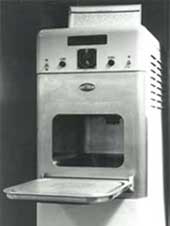 History
History 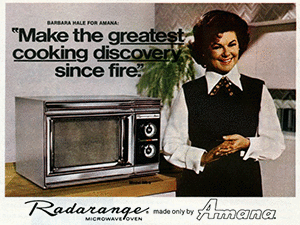
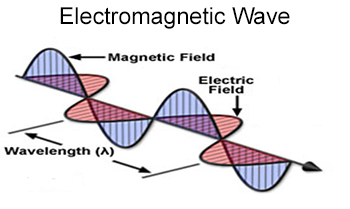
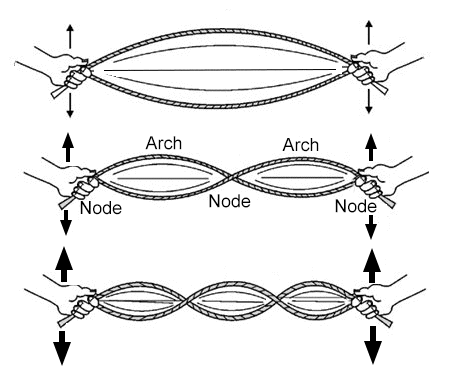

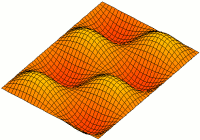
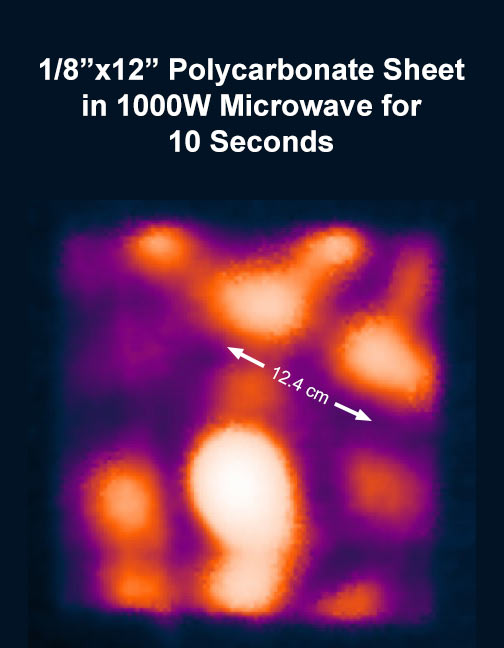
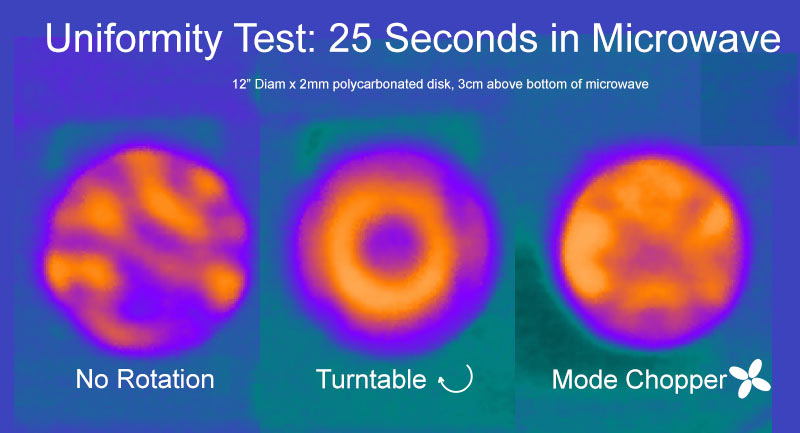
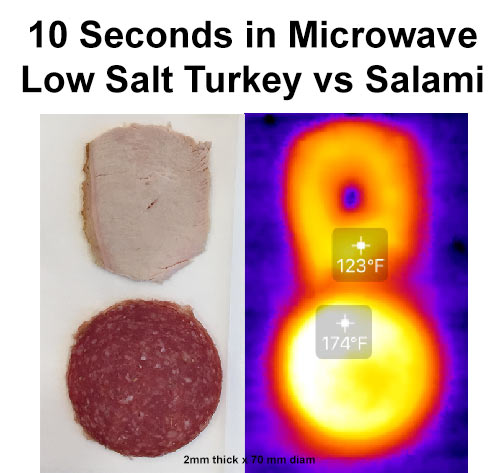

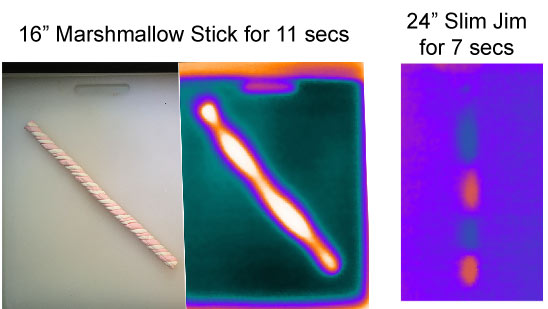
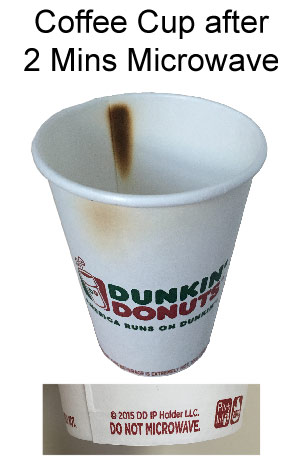
 They also adjust the size, shape, mixture, density and salinity of each portion to prevent localized thermal runaway. The thin food tray may incorporate reflective metal films, so the fish cooks slower than the veggies. Or microwave absorbing films, to crisp up a taco shell. The plastic cover has hidden vents, so the package won’t explode as water turns to steam, and to recycle a portion of the steam to heat deeper into the layer of food (which was intentionally frozen with gaps between the green beans to allow steam to circulate). Other layers absorb excess moisture, so your egg muffin doesn’t sog out. And so on.
They also adjust the size, shape, mixture, density and salinity of each portion to prevent localized thermal runaway. The thin food tray may incorporate reflective metal films, so the fish cooks slower than the veggies. Or microwave absorbing films, to crisp up a taco shell. The plastic cover has hidden vents, so the package won’t explode as water turns to steam, and to recycle a portion of the steam to heat deeper into the layer of food (which was intentionally frozen with gaps between the green beans to allow steam to circulate). Other layers absorb excess moisture, so your egg muffin doesn’t sog out. And so on.